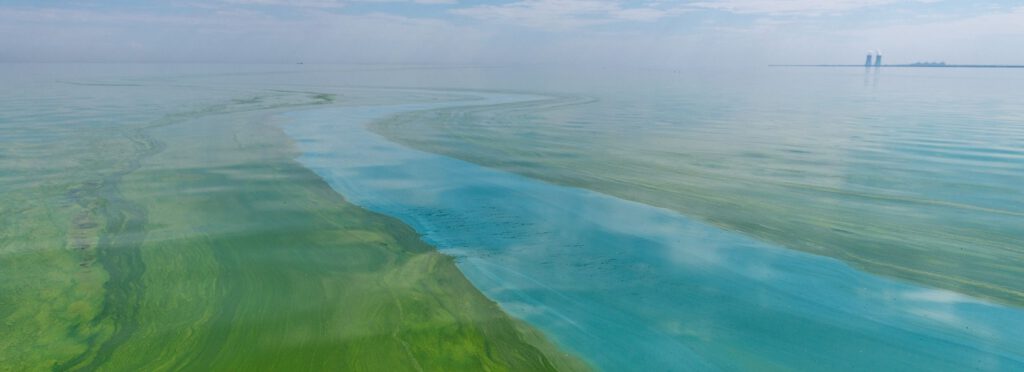Welcome to the diverse world of blue-green algae. In this short article, we follow the tracks of these microscopic troublemakers and their impact on our environment, including humans and animals. Let’s start with a first fact: Did you know that blue-green algae are not actually algae at all, but bacteria? Their name comes from the blue-green pigment that some bacteria contain – hence the commonly used name: cyanobacteria.1 Here is the overview of how these bacteria sometimes even upset the balance of the entire planet.
1. Blue-green algae are the oldest form of life on planet Earth
Blue-green algae or cyanobacteria are the oldest known fossils in existence. Fossil evidence suggests that they first appeared on Earth about 3.5 billion years ago and still live in water. They are one of the largest and most important groups of bacteria on Earth. Our basis of life, the oxygen in our atmosphere was also produced by cyanobacteria billions of years ago.1
2. The algae fern Azolla put the earth into an ice age 49 million years ago
At that time, the dramatic proliferation of Azolla led to the end of a geological age and to the climatic conditions we find today: Frozen poles and tropical temperatures at the equator. The algal fern found in freshwater forms a bond with a cyanobacterium to grow, which provides it with the nitrogen it needs and enables it to double its biomass within 2 days by also using phosphorus inputs from land. When they died in the Arctic Ocean, the plants sank to the seabed and were preserved there – the stored carbon did not find its way back into the atmosphere. Thus, the CO₂ concentration in the atmosphere was halved at that time.2
3. Blue-green algae are already responsible for hundreds of dead animals in the sea
This summer, attention was drawn to a recent disaster that occurred in North America. Hundreds of dolphins and sea lions washed up dead or sick in California due to toxic algae infestation. In Santa Barbara and Ventura, volunteers and workers have already seen more than 100 dead sea lions. They also observed 300 sea lions showing signs of ingesting the neurotoxin domoic acid.4
4. Blue-green algae can even continue to grow when their food source in the water has already disappeared
Blue-green algae seem to not only continue to exist even when their food source in the water has already been used up, but sometimes even continue to grow. This is because these bacteria have found ways to store nutrients in the water. Some of them grow quickly, absorbing a lot of nutrients in a short time and thus depriving other organisms of their livelihood, while other cyanobacteria grow slowly and at the same time store nutrients to survive even in nutrient-poor water. This allows them to remain dominant and displace other species.5
5. The area of global blue-green algal blooms on coasts is over 19 times the size of the Great Pacific Garbage Patch
A recent study published in Nature mapped daily algal blooms on 153 ocean coasts from 2003 to 2020. 123 of the coasts studied had algal blooms that significantly increased in extent and frequency over the research period. The global area of these algal blooms corresponded to a total of approx. 30.5 million km², the area of the Great Pacific Garbage Patch is currently estimated to be 1.6 million km².6, 7 Algal blooms that occurred in inland waters were not considered in these measurements (resolution 1 km).
6. Blue-green algae lead to considerable methane emissions in water bodies
In 2011, a team of researchers detected an unusually high methane level near the surface of Lake Stechlin. Investigations revealed that blue-green algae were producing the methane. Although methane production is significantly greater during the day, the bacteria also emit methane at night and in oxygen-poor and -rich environments.8 Methane has a much higher effectiveness as a greenhouse gas compared to carbon dioxide, especially in the short term. Within 20 years, its ability to contribute to climate warming is over 80 times greater than that of CO₂.3
7. Blue-green algae have a toxic effect even through inhalation
The most common routes of human exposure to cyanotoxins are: direct contact, inhalation and ingestion.9 Blue-green algae contain different toxic substances, depending on the strain. The most toxic and most frequently discovered toxin is called microcystin-LR (MC-LR), which damages the liver, negatively affects the male reproductive system and promotes liver tumours.10,11 Other toxins, such as the neurotoxin anatoxin-A, have a lethal effect in higher doses in just a few minutes to an hour, which is why bathing in blue-green algae-contaminated waters is life-threatening, especially for dogs.12
8. Exposure to toxic algae led to over 300 emergency room visits in the US over three years
A study by the Centers for Disease Control and Prevention (CDC) shows that harmful blue-green algae blooms led to 321 emergency room visits between 2017 and 2019, causing neurological, as well as respiratory, gastrointestinal, and skin problems. The number of people affected is likely to be higher, as the study was only conducted for 70 % of emergency visits nationwide.13
9. Cyanobacteria are used as a natural fertiliser in rice cultivation
Cyanobacteria are photosynthetic, which means they can produce their own food.1 This ability of cyanobacteria also serves in rice cultivation. They enter a symbiosis with the rice plant and supply it with nitrogen compounds from the air. This makes further fertilisers superfluous.14
10. Blue-green algae can grow in the most inhospitable environments
Blue-green algae have remarkable adaptability in places such as hot springs, subglacial regions of cold lakes with ice depths of up to 5 metres and the substrates of numerous rocks in deserts. Some of them even grow in a mutualistic relationship with fungi, forming compound organisms known as lichens.15
Author/Editor: Ana Petrovska, Maria Behrendt
Sources
1) Introduction to the Cyanobacteria | ucmp.berkeley
2) The arctic Azolla event | The Geological Society
3) Anthropogenic and Natural Radiative Forcing, (Seite 714) | IPCC
4) California toxic algea bloom kills or sickens hundreds of dolphins and sea lions | CNN
6) Evidence that the Great Pacific Garbage Patch is rapidly accumulating plastic | Nature
7) Coastal phytoplankton blooms expand and intensify in the 21st century | Nature
8) Blue-green algae found to produce greenhouse gas methane | phys.org
12) Diagnosis of anatoxin-a poisoning in dogs from North America | National Library of Medicine
15 ) Blue-green algae | Microorganisms, Photosynthesis & Ecology | Britannica

